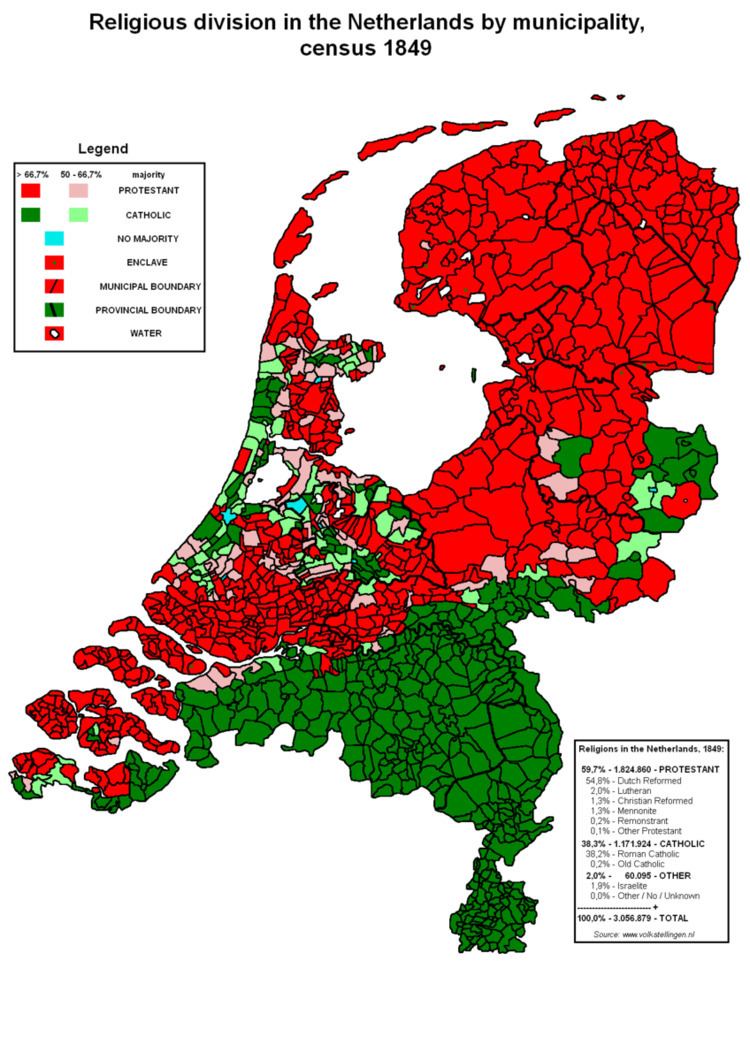 | ||
Prior to the arrival of Christianity, the ancestors of the Dutch observed a form of Germanic paganism augmented with various Celtic elements, due to the close proximity of various Celtic tribes and the general cultural blend of the region. At the start of the 6th century the first (Hiberno-Scottish) missionaries arrived. They were later replaced by Anglo-Saxon missionaries, who eventually succeeded in converting most of the inhabitants to Catholic Christianity by the 8th century. Germanic/Frankish mythology influenced Christianity, and various stories of Dutch folklore can trace origins to it.
Catholicism then dominated Dutch religion until the early 16th century, when the Protestant Reformation began to form. Early Protestantism in the form of Lutheranism did not gain much support among the Dutch, but Calvinism, introduced two decades later, did. It began its spread in the Westhoek and the County of Flanders, where secret sermons were held in the outside, called hagenpreken ("hedgerow orations") in Dutch. Gradually discontent among the Dutch grew, and erupted in 1566 with the so-called Beeldenstorm, a surge of iconoclasm, which quickly spread among all Dutch regions and finally resulted in what would become the Dutch revolt.
The ruler of the Netherlandish regions, a devout Catholic, Philip II of Spain, felt it was his duty to fight Protestantism, and, after the wave of iconoclasm, sent troops to crush the rebellion and make the Low Countries a Catholic region once more. The Protestants, many part of the merchant elite, in the Southern Low Countries (Flanders, Brabant) fled North en masse. An extreme example was the population of the city of Hondschoote, which dropped from 18,000 to a mere 385 inhabitants. Antwerp, the most powerful city in the Low Countries, lost more than half its citizens to this exodus. Equivalent movements of Catholics to the southern provinces followed.
Most of the Dutch Protestants were now concentrated in the Dutch provinces above the river Rhine, while the Catholic Dutch were situated in the Spanish ruled South. After the Peace of Westphalia in 1648, Protestantism did not spread South, resulting in a religious and political situation lasting to this day: the division of the formerly united Netherlands into two states, a largely Protestant one in the north, the modern Netherlands, and an overwhelmingly Catholic one, now Belgium, in the south. Between the 16th and the 18th centuries, many French Calvinist Protestants ( the famous " Huguenots ", persecuted in their own country ) found refuge in the Dutch Republic .
Contemporary Dutch are generally nominally Christian. People of Dutch ancestry in the United States, Canada, and South Africa are generally more religious than their European counterparts; for example the numerous Dutch communities of western Michigan remain strongholds of the Reformed Church in America and the Christian Reformed Church, both descendants of the Dutch Reformed Church, as well as other more conservative denominations such as the Protestant Reformed Church and the Netherlands Reformed Congregations.
